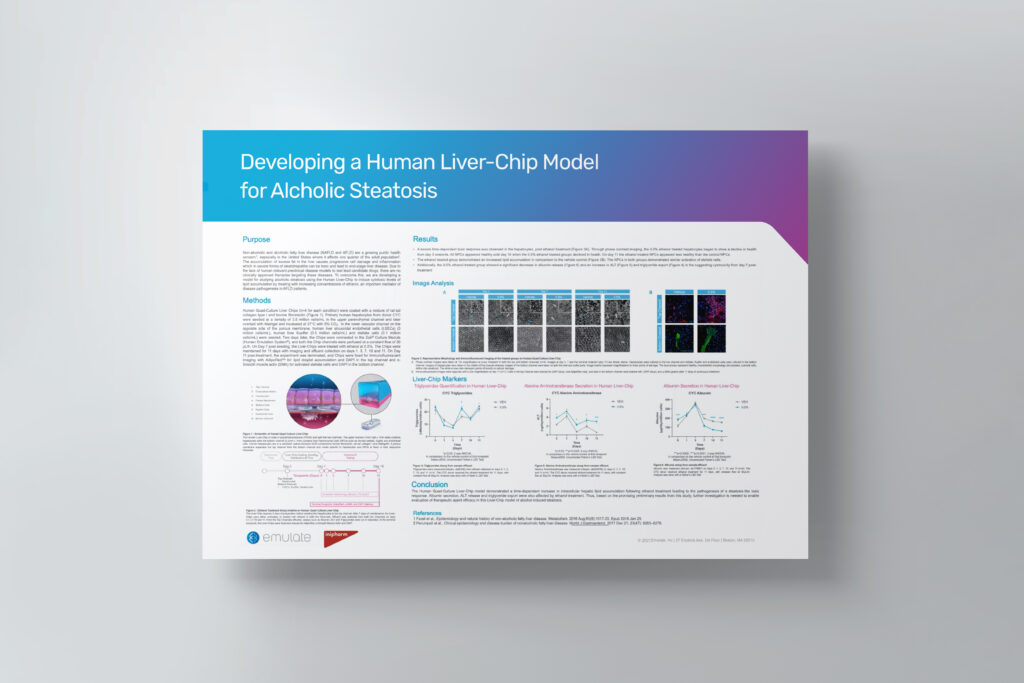Overview
Purpose:
Non-alcoholic and alcoholic fatty liver disease (NAFLD and AFLD) are a growing public health concern1, especially in the United States where it affects one quarter of the adult population2. The accumulation of excess fat in the liver causes progressive cell damage and inflammation which in severe forms of steatohepatitis can be toxic and lead to end-stage liver disease. Due to the lack of human relevant preclinical disease models to test lead candidate drugs, there are no clinically approved therapies targeting these diseases. To overcome this, we are developing a model for studying alcoholic steatosis using the Human Liver-Chip to induce cytotoxic levels of lipid accumulation by treating with increasing concentrations of ethanol, an important mediator of disease pathogenesis in AFLD patients.
Methods:
Human Quad-Culture Liver-Chips (n=3 for each condition) were coated with a mixture of rat tail collagen type I and bovine fibronectin. Primary human hepatocytes from two donors (HU8305 and CYC) were seeded at a density of 3.5 million cells/mL in the upper parenchymal channel and later overlaid with Matrigel and incubated at 37°C with 5% CO2. In the lower vascular channel on the opposite side of the porous membrane, human liver sinusoidal endothelial cells (LSECs) (3 million cells/mL), human liver Kupffer (0.5 million cells/mL) and stellate cells (0.1 million cells/mL) were seeded. Two days later, the Chips were connected to Zoë® Culture Module (Human Emulation System®), and both the Chip channels were perfused at a constant flow of 30 µL/h. On Day 7 post seeding, the Liver-Chips were treated with ethanol at 0.16% or 0.5% (v/v). The Chips were maintained for 11 days with imaging and effluent collection on days 1, 3, 7, 10 and 11. On Day 11 post-treatment, the experiment was terminated, and Chips were fixed for immunofluorescent imaging with AdipoRed™ for lipid droplet accumulation and DAPI in the top channel and α-Smooth muscle actin (SMA) for activated stellate cells and DAPI in the bottom channel.
Results:
A severe time- and concentration-dependent toxic response was observed in both hepatocyte donors, post ethanol treatment. Qualitatively, the ethanol treated groups demonstrated a concentration-dependent increase in lipid droplet accumulation and activated stellate cells, in the HU8305 hepatocytes indicative of cell damage. Similarly, the ethanol treated groups demonstrated an increase in lipid accumulation in the CYC hepatocytes, with similar stellate cell activation between the control and ethanol treated groups in this donor. Additionally, the 0.5% ethanol treated group showed a significant decrease in albumin release and an increase in ALT and triglyceride export in the CYC donor suggesting cytotoxicity from Day 7 post-treatment.
Conclusion:
The Human Quad-Culture Liver-Chip model demonstrated a time- and concentration-dependent increase in intracellular hepatic lipid accumulation (steatosis) following ethanol treatment indicative of toxicity. Activation of hepatic stellate cells, albumin secretion, ALT release and triglyceride export were also affected by ethanol treatment along with variability between the donors. Thus, based on the promising preliminary results from this study, further investigation is needed to enable evaluation of therapeutic agent efficacy in this Liver-Chip model of alcohol induced steatosis.
References:
1 Fazel et al.,Epidemiology and natural history of non-alcoholic fatty liver disease. Metabolism. 2016 Aug;65(8):1017-25. doi: 10.1016/j.metabol.2016.01.012. Epub 2016 Jan 29. PMID: 26997539.
2 Perumpail et al., Clinical epidemiology and disease burden of nonalcoholic fatty liver disease, World J Gastroenterol. 2017 Dec 21; 23(47): 8263–8276.

